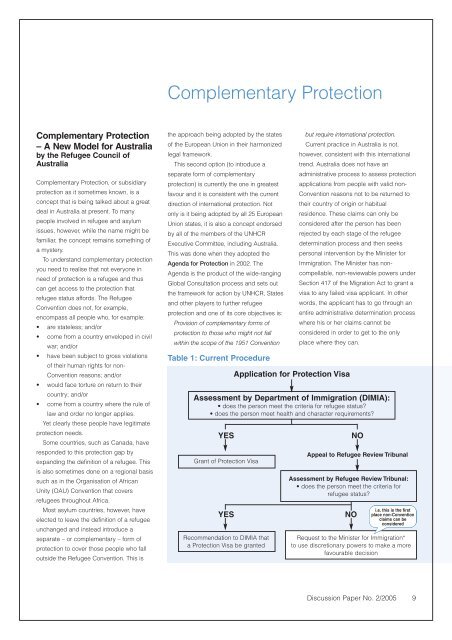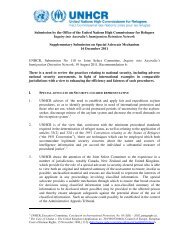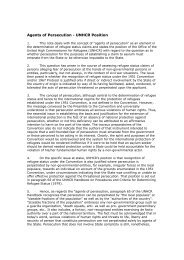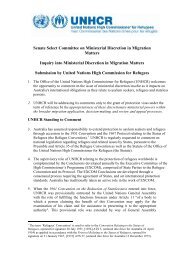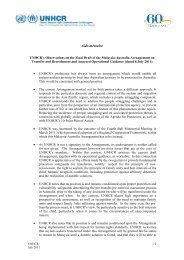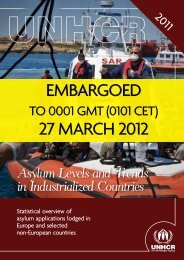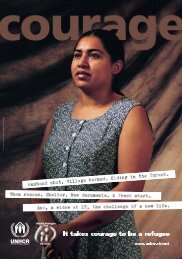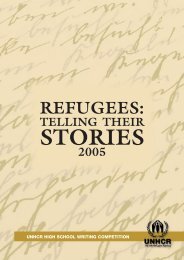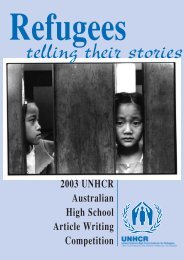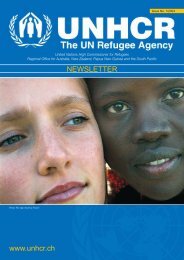Refugee Newsletter - unhcr
Refugee Newsletter - unhcr
Refugee Newsletter - unhcr
You also want an ePaper? Increase the reach of your titles
YUMPU automatically turns print PDFs into web optimized ePapers that Google loves.
Complementary ProtectionComplementary Protection– A New Model for Australiaby the <strong>Refugee</strong> Council ofAustraliaComplementary Protection, or subsidiaryprotection as it sometimes known, is aconcept that is being talked about a greatdeal in Australia at present. To manypeople involved in refugee and asylumissues, however, while the name might befamiliar, the concept remains something ofa mystery.To understand complementary protectionyou need to realise that not everyone inneed of protection is a refugee and thuscan get access to the protection thatrefugee status affords. The <strong>Refugee</strong>Convention does not, for example,encompass all people who, for example:• are stateless; and/or• come from a country enveloped in civilwar; and/or• have been subject to gross violationsof their human rights for non-Convention reasons; and/or• would face torture on return to theircountry; and/or• come from a country where the rule oflaw and order no longer applies.Yet clearly these people have legitimateprotection needs.Some countries, such as Canada, haveresponded to this protection gap byexpanding the definition of a refugee. Thisis also sometimes done on a regional basissuch as in the Organisation of AfricanUnity (OAU) Convention that coversrefugees throughout Africa.Most asylum countries, however, haveelected to leave the definition of a refugeeunchanged and instead introduce aseparate – or complementary – form ofprotection to cover those people who falloutside the <strong>Refugee</strong> Convention. This isthe approach being adopted by the statesof the European Union in their harmonizedlegal framework.This second option (to introduce aseparate form of complementaryprotection) is currently the one in greatestfavour and it is consistent with the currentdirection of international protection. Notonly is it being adopted by all 25 EuropeanUnion states, it is also a concept endorsedby all of the members of the UNHCRExecutive Committee, including Australia.This was done when they adopted theAgenda for Protection in 2002. TheAgenda is the product of the wide-rangingGlobal Consultation process and sets outthe framework for action by UNHCR, Statesand other players to further refugeeprotection and one of its core objectives is:Provision of complementary forms ofprotection to those who might not fallwithin the scope of the 1951 ConventionTable 1: Current ProcedureApplication for Protection Visabut require international protection.Current practice in Australia is not,however, consistent with this internationaltrend. Australia does not have anadministrative process to assess protectionapplications from people with valid non-Convention reasons not to be returned totheir country of origin or habitualresidence. These claims can only beconsidered after the person has beenrejected by each stage of the refugeedetermination process and then seekspersonal intervention by the Minister forImmigration. The Minister has noncompellable,non-reviewable powers underSection 417 of the Migration Act to grant avisa to any failed visa applicant. In otherwords, the applicant has to go through anentire administrative determination processwhere his or her claims cannot beconsidered in order to get to the onlyplace where they can.Assessment by Department of Immigration (DIMIA):• does the person meet the criteria for refugee status?• does the person meet health and character requirements?YESGrant of Protection VisaYESRecommendation to DIMIA thata Protection Visa be grantedNOAppeal to <strong>Refugee</strong> Review TribunalAssessment by <strong>Refugee</strong> Review Tribunal:• does the person meet the criteria forrefugee status?NOi.e. this is the firstplace non-Conventionclaims can beconsideredRequest to the Minister for Immigration*to use discretionary powers to make a morefavourable decisionDiscussion Paper No. 2/20059


